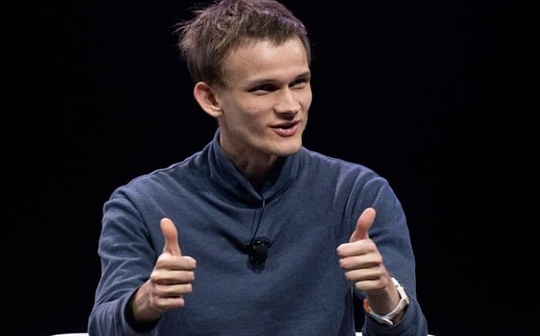
Written by: Vitalik Institute of Thought
On July 30, 2015, the Ethereum main network was launched.
Bitcoin grows like a myth, depersonalized and unwritten; Ethereum is like an unfinished script, and the author never leaves the stage.
Vitalik Buterin, a young and famous tech idealist, spent ten years injecting his personal philosophy, values and struggles into code.
From the initial vision of “world computers” to governance reflections under the DAO crisis, from mergers (Merge) to the foundation’s deep transformation…Ethereum’s evolution has carved traces of Vitalik’s thoughts.
Ethereum’s decade is also a history of the evolution of Vitalik’s thoughts.
The genius utopia
In 2008, a financial crisis brought about an unprecedented storm.
As banks collapsed and trust collapsed, Bitcoin emerged and sounded the horn of rebellion against the old world.This emerging technology not only attracted geeks and cryptography enthusiasts, but also changed the life trajectory of a teenager.Vitalik Buterin.
Since ancient times, heroes have been young. At the age when most people encounter love, 17-year-old Vitalik has encountered Bitcoin.
In 2011, he learned about Bitcoin from his father, a computer scientist. After giving up World of Warcraft, Bitcoin became Vitalik’s new hobby.
He started searching for Bitcoin forums online until he found a willingPay his article with BitcoinPeople, thenheYou can earn 5 for every blog postBitcoin.
Vitalik’s article quickly caught the attention of Romanian Bitcoin enthusiast Mihai Alisie.The two began correspondence and co-founded Bitcoin Magazine at the end of 2011.
In 2013, Vitalik used the bitcoins earned by his articles to travel around the world, visiting local Bitcoin enthusiasts in Israel, London, San Francisco, Los Angeles and other places. When he returned to Toronto,Very sure that everyone is about blockchain 2.0The understanding is completely wrong.
Because they all try to build complex applications on Bitcoin, but the functionality of Bitcoin scripts is too limited.
Vitalik realized that if he wrote a version of Bitcoin with a Turing complete programming language, the network could provide all digital services, replicating social networks on the blockchain, restructuring stock markets, and even building fully digital companies, without being governed by any government entity.
In November of the same year, 19-year-old Vitalik turned the idea into a white paper and gave it its name:Ethereum.
This white paper quickly swept across the entire crypto circle, and for the first time people realized that blockchain can be more than just a currency, but also a global decentralized platform.
Co-founders such as Joseph Lubin and Gavin Wood have joined in, and Lubin even called him a “genius alien who brought decentralized gifts.”
Vitalik of that period was an extremely pure idealist. In an interview, he did not shy away from it, saying that he had a dualistic worldview.It is believed that most social ills are attributed to centralization.“I see everything that involves government regulation or business control as pure evil.”
However, there is always a gap between idealism and reality.
The disagreement first broke out within the team.Some co-founders want Ethereum to become a profitable business entity, while Vitalik is more willing to stick to a non-profit, open community model. He even proposed to reduce the proportion of distribution he and other founders in Ethereum to avoid future concentration of power.
In June 2014, the conflict reached its peak.
Vitalik asked Charles Hoskinson and Amir Chetrit to leave the team and set up the Ethereum Foundation (EF) the same year to establish the direction of non-profit governance.That same year, Gavin Wood also left behind due to disagreements with Vitalik on development priorities and nonprofit directions, and founded Polkadot in 2020.
In an interview with TIME, Vitalik acknowledged that Ethereum’s vision of change was at risk of being overwhelmed by greed:
“If we don’t make our voice, there are only things that can be built that can be profitable immediately, and they are often not what the world really needs.”
On July 30, 2015, dozens of young developers witnessed the automatic launch of the Ethereum mainnet in a small office in Berlin.There are no luxurious celebrations, no large-scale media coverage, only a group of idealists quietly watching the running blocks on the screen.
The vision of “World Computer” moves from a white paper to a reality.
Behind the halo, however, the young Vitalik is not ready for a more complex and cruel real world.
Ideal cracks
In the first few years of Ethereum’s birth, Vitalik was more like a purely tech utopian.He firmly believes that the ultimate significance of blockchain lies in decentralization, emphasizing that anyone can freely build applications on Ethereum without the approval of central authorities.
In 2015, Vitalik repeatedly emphasized the open, trustless nature of Ethereum, depicting an ideal world dominated by code rather than power.
But decentralization does not mean that everything will naturally become better.Vitalik is both opposed to centralization and inevitably becomes the ultimate arbiter of community opinions.This subtle powerparadoxNextofDAODangerIt is completely enlarged in the machine.
In 2016, The DAO was the world’s first decentralized investment fund running on Ethereum, raising more than 12 million Ethereums worth $150 million.However, in June, a hacker launched an attack using a smart contract vulnerability and stole about 3.6 million ETH.
That year, Vitalik was only 22 years old and was just used to being called “God of V”.After the crisis broke out, he communicated with the community almost sleeplessly every day, formulated plans, and tried to remedy it.
The urgent need to protect investors’ assets has formed a huge conflict with the decentralized technological creed.Ultimately, Vitalik chose a compromise and pragmatic path: advocating for the recovery of stolen funds through hard forks and letting the entire community vote.
This decision successfully stabilized the market and split the former Ethereum into today’s ETH and ETC.
In this crisis, Vitalik lost not only his sleep, but also his confidence in the “perfect execution” of smart contracts and the original “perfect” image of the leader, which is also because of this incident.That 100% trusting technology “saint” is gone, and a more pragmatic Vitalik is on the way.
After the DAO crisis, Vitalik acknowledged the gap between ideal and reality in his blog Thinking About Smart Contract Security.He raised the need to introduce stricter security audits and formal verification, and began talking about governance in public speeches, emphasizing that “community collaboration” rather than technological absolutism is the key to Ethereum’s success.
The crisis brought reflection, but the market quickly entered a period of speculative fanaticism, bringing heavy online burdens.
In 2017, ICO (initial token issuance) became a phenomenon-level financing method, and projects such as EOS, Tezos, and Bancor easily raised hundreds of millions of dollars on Ethereum.At the end of the same year, NFT game CryptoKitties caused serious congestion on Ethereum due to the surge in users, and Gas fees once exceeded 800 Gwei. Vitalik realized:If the scalability problem is not solved, Ethereum will find it difficult to realize its inclusive vision.
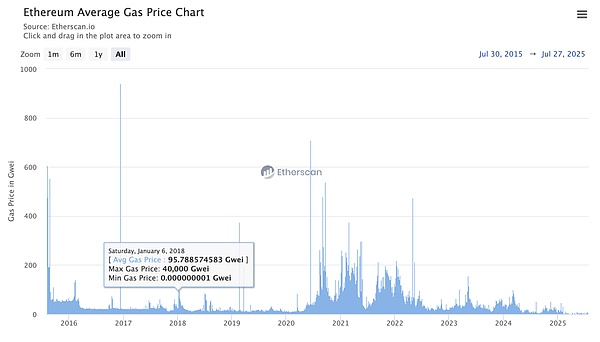
In the interview, he did not hide his disappointment with industry speculation:
“Many projects seem decentralized, but in fact they are just changing their packaging. We must prove that the reason for blockchain exists is really better than traditional technologies (such as Excel tables).”
The craze quickly receded, and the overall crypto market collapsed in 2018, with ETH falling from $1,400 to $83, and a large number of ICO projects vanished.
During this period, Vitalik has been thinking about how to pull blockchain back into meaningful directions.
In 2018, he co-published “Liberal Activism: A Flexible Charitable Donation Mechanism Design”, with Harvard scholar Zoë Hitzig and Microsoft researcher Glen Weyl, proposing a quadratic voting mechanism, hoping to allow truly valuable public goods to be supported by resource through the public funding model rather than being dominated by short-term speculation.
In response to problems such as network congestion caused by insufficient scalability, Vitalik and community developers proposed EIP-1559, introducing a dynamic Gas fee mechanism, and promoting Ethereum to shift from Proof of Work (PoW) to Proof of Stake (PoS) to reduce energy consumption and improve transaction throughput.
The DAO crisis, speculative bubbles and price collapse have sent Vitalik with a profound ideological twist.He went from being a “technical saint” who pursued the ultimate decentralization to a builder who must consider security, governance and social values.
Ethereum is still his utopia, but it is no longer a purely technological paradise, but a rugged path to reality that requires compromise, trade-offs and a broader perspective.
In this process, Vitalik gradually found his own pragmatic philosophy.
A battlefield outside of code
If Vitalik from 2015–2019 has undergone a transition from pure technological idealism to pragmatism, then from 2020–2022 he has experienced another key turning point in his mind:He began to face the complexity of the real world, moving from a simple artistic ideal to a multi-dimensional thinking that takes into account social governance, public responsibility and real politics.Especially the Russian-Ukrainian war, he began to use his influence to face politics.
In August 2020, he proposed in his blog post “Trust Models”,Blockchain can never be completely “trustless”, and the social contracts and power relations in reality cannot be completely eliminated.This is in stark contrast to his early years of thinking that he wanted to completely replace human consensus with code.
In 2021, Vitalik criticized the single token voting governance model in his blog post “Moving Beyond Coin Voting Governance”, believing that capital weight should not be the only decision-making logic, and called for the establishment of a diversified consensus and soft governance mechanism to try to make blockchain more in line with the decision-making logic of human society.
An idealist, further integrate into reality.
2022 is a year of great challenges for Ethereum and Vitalik – Merge.
From PoW to PoS, the process of changing the consensus mechanism is not smooth.A large number of former Ethereum community members criticized PoS for essentially further concentrating its power in the hands of large capital holders, while some miners and node operators expressed dissatisfaction with the abandonment of the PoW mining model that has been hard-working for many years.
Cardano founder Charles Hoskinson even described Vitalik as an Ethereum dictator. He criticized Ethereum as a “dictatorial regime” and Vitalik held too much power.
Even so, Vitalik and the Foundation are firmly advancing the merger.On September 15, Ethereum officially completed Merge, and PoW withdrew from the stage of history.
Vitalik emphasized that this upgrade is not only a sharp reduction in PoW’s energy consumption (about 99.95% reduction in energy consumption), but also lays the foundation for future steps such as Sharding and Rollup expansion, making it possible to exceed thousands or even tens of thousands of transactions per second.
Regarding the “dictator”, he responded that Ethereum governance relies on community consensus rather than single-person rulings, and all major changes were passed through EIP, core developer meetings and public discussion.
In February of the same year, the Russian-Ukrainian war broke out.
Vitalik, a Russian-born and Moscow-born, rarely broke “neutrality” and condemned Putin in Russian on Twitter, calling it a “crime against Ukraine and the Russian people” and wrote the widely circulated phrase:“Ethereum is neutral, but I’m not.”
Just a few weeks later, Vitalik extended a helping hand to Ukraine through crypto donations, and donated a total of two major channels, the Unchain Fund and Aid for Ukraine.1,500 ETH (approximately $5 million)Used for humanitarian and military support.
In September of the same year, he went to Kiev in person to attend the Kyiv Tech Summit and ETHKyiv Hackathon to express his support for Ukraine.
“I want to see for myself the Ethereum project that is still booming in the war and understand the developers behind it,” he said. “Ukraine could be the next Web3 hub.”
“Just build Ethereum well, why do you mix politics?”
Vitalik is criticized again, but he doesn’t care at all. In an interview with Time, he admitted: “One of the decisions I made in 2022 is to try to be more risky and stop being neutral.I would rather Ethereum offend some people than become an empty shell that nothing represents.”
This sentence also indicates that Vitalik’s “offensive” scope is still expanding, and social value has become the core of his attention.Even the NFT boom that could benefit Ethereum that year failed to escape Vitalik’s sharp criticism.
“If encryption is just to get people to buy and sell monkey pictures and get rich, it will lose its meaning of existence.”
Especially after Luna collapsed and FTX collapsed, Vitalik believed that the real problem in the encryption world was no longer the security and expansion capabilities of the underlying protocol.It is how to realize social value at the application level.
He called on the community to build a decentralized application of transparent financial instruments that can improve public governance, fund public goods, and promote the development of transparent financial instruments.
sameIn his 2019 blog post “What in the Ethereum application ecosystem excites me”, he listed the application directions he most looked forward to:
-
A scaling solution with Layer 2 and Rollup as the core;
-
Privacy protection technology based on zero-knowledge proof;
-
DAO driven by public goods funding mechanisms;
-
Predictive markets and stablecoins that solve real-life problems.
After experiencing merger controversy, war shocks, speculative frenzy and industry collapse, Vitalik is no longer just a geek sitting behind the code.For the first time, he took the initiative to come to the forefront and participated in public issues as actors and thinkers.
His ideal country began to have a new outline:It is not only a technical architecture, but also a multi-dimensional experimental field where governance, freedom and public value coexist.
Dawn in the dark
After Merge is completed, Ethereum’s technology route has entered a stable period.
At this moment, the NFT craze has receded and the DeFi popularity has dissipated. The crypto industry has once fallen into the anxiety of “no new narrative”. Vitalik has continuously promoted the concept of public goods funding and information finance at this stage:
-
Support open source development and community governance through Gitcoin and quadratic funding mechanisms;
-
Explore predictive markets and data financial tools to make information a valuable and incentivized asset;
-
Advocate more decentralized applications that focus on social issues and public governance rather than purely hype tools.
At the same time, ChatGPT has driven the AI wave to sweep the world, and the Silicon Valley technology school is popular in “effective accelerationism (e/acc)” and believes that technology and innovation should be faster, the better, and are optimistic and welcomed by AGI.
However, Vitalik stood on the opposite side and proposed another prudent path – “d/acc” – advocating that technological development should give priority to “defense” and protect democratic and decentralized order, which is highly consistent with Ethereum’s original intention.In his blog post My techno‑optimism, he warns about the risks of centralization of AI:“A government controlled by 45 people may control the fate of billions of people.”
The alertness brought by AI and the development of Ethereum are intertwined in Vitalik’s mind. In Make Ethereum Cypherpunk Again, he called on Ethereum to regain the early crypto spirit:Privacy protection, open source collaboration, and decentralized power.
This point was emphasized by him in the interview that Ethereum is not an institutional tool, but an infrastructure for individual empowerment.Its meaning is to resist the centralization of power, rather than becoming a new centralized order.
However, there is always a gap between ideals and markets.
In 2024, the crypto market did not follow Vitalik’s guidance, but went in the direction he criticized.The privacy, Layer2 and other technical narratives he advocated were neglected by the market, and ETH prices have been sluggish for a long time. Instead, MEME has stood at the center of the stage. Solana has been praised by some investors as “new Ethereum” with its high-speed performance and MEME ecosystem.
The market has begun to prevail in the saying that “Ethereum has aging” and “foundations have lost their innovation”, and the Chinese community is in constant fire: foundations are accused of frequent sales of ETH, ignoring developer support, researchers have conflicts of interest with external projects, and Vitalik is filled with the voices of eunuchs’ flattery…
Vitalik doesn’t hide his frustration on X: Crypto Twitter and VC see “KOL bets with 99% of users losing money” as the industry’s best product; the outside world knows nothing about the foundation, but asks him to complete a thorough reform within two weeks.These voices made him want to quit, but every time he wanted to give up, there were always some signals to remind him that it was “worth continuing to fight”:
“Don’t deny yourself, make yourself unshakable.”
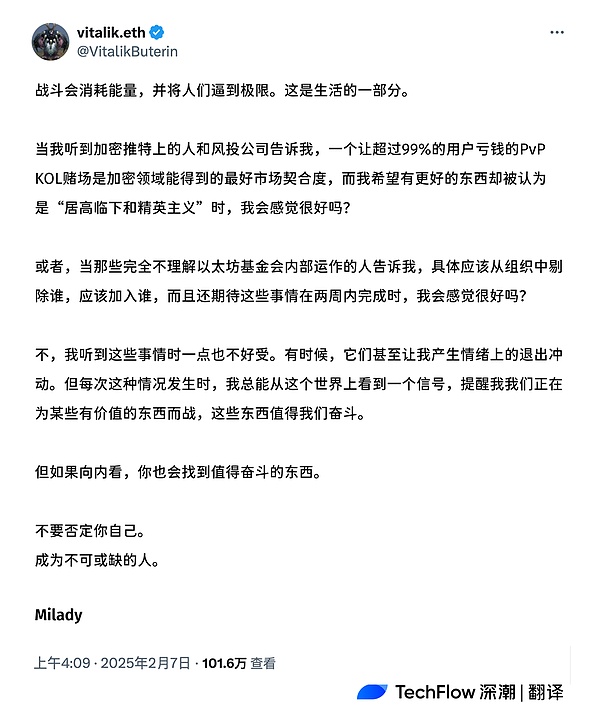
Criticism remains, but change is happening.
In January 2025, Vitalik issued a statement on X, carrying out major reforms to the leadership structure of the Ethereum Foundation; in March, the Ethereum Foundation announced major personnel adjustments:
Former Executive Director Aya Miyaguchi is transferred to the Foundation Chairman;
Hsiao‑Wei Wang and Tomasz Stańczak were promoted to new co-executive directors;
Core researcher Danny Ryan founded the new experimental organization Etherealize to accelerate the implementation of technology.
As the core infrastructure, Ethereum has once again become the focus with the launch of Circle and the rise of stablecoins and RWA concepts.
Consensys founder Joseph Lubin uses US stock company SharpLink Gaming (SBET) to launch “ETH reserves” and become the “Ethereum version of MicroStrategy”.BitMine, Bit Digital, GameSquare and other companies followed up, and the ETH reserve competition kicked off.
ETH price doubled since April, with a monthly increase of 40% in July, and the market seems to have forgotten its doubts about Ethereum a few months ago.
Vitalik did not explicitly agree or deny the “micro-strategy” model, but at EthCC in early July, Vitalik Buterin issued his industry warning again:Web3 is standing at a crossroads, and unless developers anchor their work to freedom, decentralization, and privacy, the industry has the potential to betray its founding principles.
“Ethereum is at a critical moment,” he said. “The dream of decentralization that drives the blockchain revolution is now fading due to corporate engagement, political attention and user convenience.”
On July 30, the 10th anniversary of Ethereum’s launch.
Vitalik X’s homepage forwarded the “Ten Years of Ethereum Insights” by Binji, a member of the Ethereum Foundation:
“When the bank goes bankrupt,Cloud ServiceEthereum is still running when the fire is turned off and the server is patched.We are still moving forward.Ten years online, always move forward.”
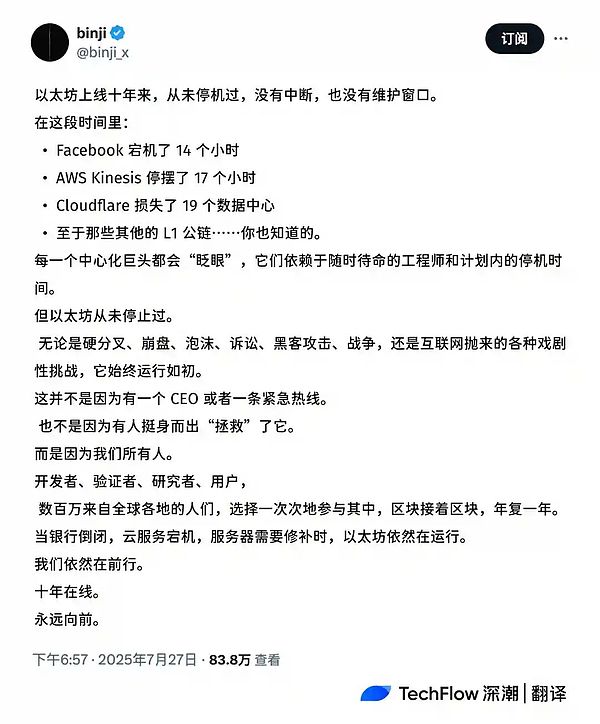
Interestingly, Vitalik recently reposted a transcription of his favorite lyrics, from S.H.E’s song “Starlight”:
If the night is not dark, why yearn for a beautiful dream
Dawn will be the last reward for those who persist
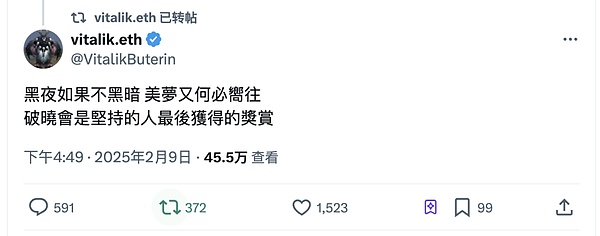
This seems to be the best footnote to the storm of Ethereum and Vitalik over the past two years:In the dark night, he chose to persevere and wait for the dawn to break.


